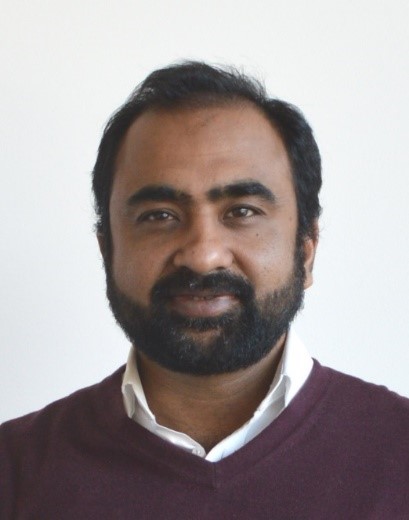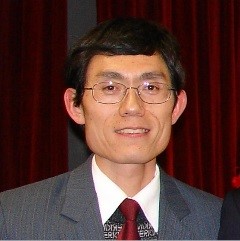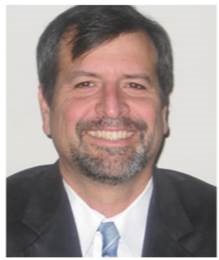










|
Technical Program
(1) What comes after Prognostic:
Keynote Speaker: Dr. Kai Goebel, Principal Scientist, Palo Alto Research Center (PARC), USA

Bio: Dr. Kai Goebel is a Principal Scientist in the System Sciences Lab (SSL) at PARC. His particular interest is systems health management and autonomy for a broad spectrum of cyber-physical systems in the energy, transportation, aerospace, defense, and manufacturing sectors. Prior to joining PARC, Kai worked at NASA Ames Research Center where he was the Area Lead for Discovery and Systems Health, leading a team of 70 people. The work spanned machine learning, physics modeling, quantum computing, and prognostics and systems health management as applied to aeronautics and space applications. Between 1997 and 2006, he worked at GE Corporate R&D where he developed data-driven techniques for a number of GE’s industrial applications. Dr. Goebel is an adjunct professor at Lulea Technical University, co-founder of the PHM Society and associate editor of the International Journal of PHM. He has been co-adviser to 14 Ph.D. students, holds 18 patents in PHM related fields, and has co-authored over 300 technical papers.
Abstract: Much technical development in PHM has been dedicated to the advancement of various techniques for carrying out estimation of remaining life. The question that needs to be asked then is: what happens once you have a remaining life estimation in hand. The answer may not always be completely straightforward since it requires trading off different objectives to maximize the operator's benefit. This talk will provide a perspective for the different elements that one may need to consider in post-prognostic decision making.
(2) Structural Health Monitoring from Diagnostics to Prognostics:
Keynote Speaker: Dr. Fu-Kuo Chang, Professor, Stanford University; Editor-in-Chief, International Journal of Structural Health Monitoring, USA
 Bio: Dr. Fu-Kuo Chang is a Professor in the Department of Aeronautics and Astronautics at Stanford University. He received his PhD. from U. of Michigan in 1983. His primary research interest is in the areas of multi-functional materials and intelligent structures with particular emphases on structural health monitoring, self-sensing diagnostics, intelligent sensor networks, and multifunctional energy storage composites for transportation vehicles as well as safetycritical assets. He is the Editor-in-Chief of the international Journal of Structural Health Monitoring, recipients of the 2018 PHM Society Life-time Achievement award, the 2010 SPIE Smart Structures/NDE Life-Time Achievement award, and the 2004 SHM Life-time Achievement award by Boeing Company. Founding Chair of the International Aerospace Industry Steering Committee for Structural Health Monitoring (AISC-SHM); Fellows of American Institute of Aeronautics and Astronautics and American Society of Mechanical Engineers. Bio: Dr. Fu-Kuo Chang is a Professor in the Department of Aeronautics and Astronautics at Stanford University. He received his PhD. from U. of Michigan in 1983. His primary research interest is in the areas of multi-functional materials and intelligent structures with particular emphases on structural health monitoring, self-sensing diagnostics, intelligent sensor networks, and multifunctional energy storage composites for transportation vehicles as well as safetycritical assets. He is the Editor-in-Chief of the international Journal of Structural Health Monitoring, recipients of the 2018 PHM Society Life-time Achievement award, the 2010 SPIE Smart Structures/NDE Life-Time Achievement award, and the 2004 SHM Life-time Achievement award by Boeing Company. Founding Chair of the International Aerospace Industry Steering Committee for Structural Health Monitoring (AISC-SHM); Fellows of American Institute of Aeronautics and Astronautics and American Society of Mechanical Engineers.
Abstract: The structural health monitoring (SHM) community has long been focused on diagnostic techniques based on sensor data for detection and monitoring of damage in various structural platforms. Due to recent significant progress in maturing SHM technology, considerable efforts have greatly been emphasized on its reliability of detection and quantification of damage. Numerous methods and techniques have been proposed for quantifying the probability of detection and damage localization and sizing. With improved SHM performance in reliability and accuracy in damage quantification, it becomes much more apparent that the SHM diagnostic results could be integrated with existing prognostic methods to provide more accurate and reliable predictions on the remaining life and integrity of the damaged structures in a real-time basis through continuing the monitoring of the sensor data from SHM systems. This presentation will review the current progress in structural health monitoring with a particular focus on acousto-ultrasound techniques for monitoring and quantifying the integrity of metallic or composite structures and multifunctional composite structures with embedded batteries from the Structures and Composites laboratory at Stanford University.
(3) Industrial AI for Maintenance and Repair: Recent Advances and New Applications
Keynote Speaker: Dr. Chetan Gupta, Chief Data Scientist and Architect, Lab Manager, Industrial AI Lab, Hitachi America Ltd., USA
 Bio: Bio: Dr. Chetan Gupta is the Chief Data Scientist & Architect, and manages the Industrial AI Lab at Hitachi America R&D. Chetan has more than 15 years of experience in analytics, AI, big data, and related domains. Over his career he has worked both as a machine learning data scientist as well as in designing systems and architectures for big data applications. At Hitachi, he manages a large team of data scientists, architects and developers that is engaged in developing cutting edge solutions and opening new frontiers in the area of industrial analytics. His team builds fundamental horizontal technologies that are then used to build solutions for industry specific verticals. He has led efforts to build horizontal solutions in predictive maintenance, quality, operations monitoring and control, and for verticals such as mobility, mining, building energy management systems, etc. Over the years Chetan has led multiple research and development teams, and mentored young researchers. He has close to 50 patents either granted or under review and more than 40 publications in the areas of data mining/machine learning, data stream systems, complex event processing, workload management, etc. Chetan has a Ph.D. in Mathematics and M.S. in Mathematical Computer Science and Chemical Engineering from University of Illinois, Chicago. Bio: Bio: Dr. Chetan Gupta is the Chief Data Scientist & Architect, and manages the Industrial AI Lab at Hitachi America R&D. Chetan has more than 15 years of experience in analytics, AI, big data, and related domains. Over his career he has worked both as a machine learning data scientist as well as in designing systems and architectures for big data applications. At Hitachi, he manages a large team of data scientists, architects and developers that is engaged in developing cutting edge solutions and opening new frontiers in the area of industrial analytics. His team builds fundamental horizontal technologies that are then used to build solutions for industry specific verticals. He has led efforts to build horizontal solutions in predictive maintenance, quality, operations monitoring and control, and for verticals such as mobility, mining, building energy management systems, etc. Over the years Chetan has led multiple research and development teams, and mentored young researchers. He has close to 50 patents either granted or under review and more than 40 publications in the areas of data mining/machine learning, data stream systems, complex event processing, workload management, etc. Chetan has a Ph.D. in Mathematics and M.S. in Mathematical Computer Science and Chemical Engineering from University of Illinois, Chicago.
Abstract: The structural health monitoring (SHM) community has long been focused on diagnostic techniques based on sensor data for detection and monitoring of damage in various structural platforms. Due to recent significant progress in maturing SHM technology, considerable efforts have greatly been emphasized on its reliability of detection and quantification of damage. Numerous methods and techniques have been proposed for quantifying the probability of detection and damage localization and sizing. With improved SHM performance in reliability and accuracy in damage quantification, it becomes much more apparent that the SHM diagnostic results could be integrated with existing prognostic methods to provide more accurate and reliable predictions on the remaining life and integrity of the damaged structures in a real-time basis through continuing the monitoring of the sensor data from SHM systems. This presentation will review the current progress in structural health monitoring with a particular focus on acousto-ultrasound techniques for monitoring and quantifying the integrity of metallic or composite structures and multifunctional composite structures with embedded batteries from the Structures and Composites laboratory at Stanford University.
Tutorials
(1) Using Fractional Failure for Reliability Assessment under Uncertainty
Tutorial Speaker: Dr. Feng-Bin (Frank) Sun, Tesla Inc.
 Bio: Dr. Feng-Bin (Frank) Sun is currently a Senior Staff of Reliability Engineering and Technical Lead of Manufacturing Reliability at Tesla Inc. with over 30 years of industry and academia experience. Prior to joining Tesla, he worked at HGST, a Western Digital Company, as a Senior Technologist of Reliability Engineering from 2010 to 2015, at Western Digital Corporation as a Technical Team Leader from 2003 to 2010, and at Maxtor-Quantum Corporation as a Senior Staff Reliability Engineer from 1997 to 2003. He has published two books, both by Prentice Hall, and more than 50 papers in various areas of reliability, maintainability and quality engineering. He received his Ph.D. in Reliability from University of Arizona. Dr. Sun served in the editorial board as an Associate Editor for the IEEE Transactions on Reliability from 1999 to 2003 and from 2016 to present, Program Chair of ISSAT International Conference on Reliability and Quality in Design since 2014, and a committee member and session moderator of numerous international conference on reliability. He is a member of ASQ and the President for Society of Reliability Engineers (SRE) Silicon Valley Chapter. He is also the program manager in charge of ASQ Reliability Webinar Mandarin Series. Dr. Sun received the RAMS 2013 A.O. Plait Best Tutorial Award. Bio: Dr. Feng-Bin (Frank) Sun is currently a Senior Staff of Reliability Engineering and Technical Lead of Manufacturing Reliability at Tesla Inc. with over 30 years of industry and academia experience. Prior to joining Tesla, he worked at HGST, a Western Digital Company, as a Senior Technologist of Reliability Engineering from 2010 to 2015, at Western Digital Corporation as a Technical Team Leader from 2003 to 2010, and at Maxtor-Quantum Corporation as a Senior Staff Reliability Engineer from 1997 to 2003. He has published two books, both by Prentice Hall, and more than 50 papers in various areas of reliability, maintainability and quality engineering. He received his Ph.D. in Reliability from University of Arizona. Dr. Sun served in the editorial board as an Associate Editor for the IEEE Transactions on Reliability from 1999 to 2003 and from 2016 to present, Program Chair of ISSAT International Conference on Reliability and Quality in Design since 2014, and a committee member and session moderator of numerous international conference on reliability. He is a member of ASQ and the President for Society of Reliability Engineers (SRE) Silicon Valley Chapter. He is also the program manager in charge of ASQ Reliability Webinar Mandarin Series. Dr. Sun received the RAMS 2013 A.O. Plait Best Tutorial Award.
Abstract: This tutorial provides a systematic and comprehensive introduction of the concept of fractional failure, the actual scenarios when fractional failures are present, mathematical modeling, and data analysis. Numerous examples are given to illustrate the applications through various popular reliability software.
This tutorial is developed based on numerous publications of the author since 1994. In classical reliability engineering and life data analysis, the state of an item is binary: survive or fail (“1†or “0, “S†or “Fâ€). The number of each state, or the number of failures or survivors, is always an integer. For example, a 6-week life testing of 100 units yielded 5 failures and 95 survivors. However, in real world practice, fractional failures, and therefore fractional survivors as well, can be encountered at various scenarios. For example, the number of chargeable failures is fractional when
1. Corrective actions (CA) are partially effective (less than 100%),
2. Performance degradation has crossed the pre-specified threshold but hasn't manifested as a physical failure yet,
3. Initial failure analysis cannot duplicate the field failure symptom due to failure diagnosis limitation,
4. Actual root cause is not readily available for each failure due to lack of FA resource, but there are empirical knowledge for the likelihood for each potential root cause, etc.
5. The consequence (harm) of a failure or hazard is diversified and uncertain, but the risk needs to be assessed for each, etc.
It may be seen the above scenarios share one thing in common; i.e., the state of the subject in study is not known or uncertain. However, engineers and management often have to conduct reliability growth trend projection, risk assessment, and decision making under such scenarios. Conducting scientific reliability analysis of the above scenarios requires proper status classification, modeling structure, and handling of the data entry by the reliability analysis software. Fortunately, as indicated in the tutorial that using MLE parameter estimation as an example, it is not too big a task for most reliability related software in the market to accommodate fractional failures. Some of them can already handle such scenarios (but with different data entry formats). The key is for the reliability practitioners to realize the existence of the fractional failures and survivors, quantify their likelihood, enter the data correctly, and interpret the results properly. Numerical examples are given, with the most popular commercial software in the market, such as Weibull++, JMP, and Minitab, to demonstrate the actual application in the real world practice including data collection, failure classification and fractional failure determination, data entry format, life distribution parameter estimation, reliability quantification, and field risk prediction. It is the author's experience and belief that fractional failure will become a norm, instead of an exception, due to the nature of failure initiation, development, and manifestation, effectiveness of corrective actions, failure-physics based identification of the sub-healthy condition using parametric degradation analysis techniques, failure analysis resource and capability limitation, etc. This is especially true with the advancement of failure physics, sensing technologies, and big data. It is hoped that this paper will be beneficial to a wide audience including reliability engineers, theorists, and management.
(2) Dimensionality Reduction Theories for PHM
Tutorial Speaker: Dr. Yixiang Huang, Assistant Professor, Shanghai Jiaotong University, China
 Bio: Dr. Yixiang Huang is an Assistant Professor in the Department of Mechanical Engineering at Shanghai JiaoTong University, China. Previously, he worked from 2010 to 2012 as a researcher and postdoctoral fellow at the NSF Industry/University Cooperative Research Center for Intelligent Maintenance Systems at the University of Cincinnati, USA. His current research interests include intelligent maintenance, prognostics and health management, dimensionality reduction techniques, big data analysis and sparse coding for various applications. He has applied advanced data driven techniques in fault diagnosis, anomaly detection, prognostics and health management not only to the industrial assets such as construction and mining equipment, machine centers, assembling production line, mixshield machine, wind turbines, batteries, robots, but also to the non-industrial applications such as electroencephalography (EEG) and electrocardiogram (ECG) signals for human health assessment. He has authored over 40 publications in referred journals and conference proceedings. He has served as the paper review chairs, session chairs in several international conferences such as COMADEM, International Conference on Sensing, Diagnostics, Prognostics, and Control (SDPC), etc. Bio: Dr. Yixiang Huang is an Assistant Professor in the Department of Mechanical Engineering at Shanghai JiaoTong University, China. Previously, he worked from 2010 to 2012 as a researcher and postdoctoral fellow at the NSF Industry/University Cooperative Research Center for Intelligent Maintenance Systems at the University of Cincinnati, USA. His current research interests include intelligent maintenance, prognostics and health management, dimensionality reduction techniques, big data analysis and sparse coding for various applications. He has applied advanced data driven techniques in fault diagnosis, anomaly detection, prognostics and health management not only to the industrial assets such as construction and mining equipment, machine centers, assembling production line, mixshield machine, wind turbines, batteries, robots, but also to the non-industrial applications such as electroencephalography (EEG) and electrocardiogram (ECG) signals for human health assessment. He has authored over 40 publications in referred journals and conference proceedings. He has served as the paper review chairs, session chairs in several international conferences such as COMADEM, International Conference on Sensing, Diagnostics, Prognostics, and Control (SDPC), etc.
Abstract: This tutorial will start with a brief review of the dimensionality reduction techniques, with some of the key concepts associated with data analysis and visualization, for applications of both linear and non-linear data sets, also for time sensitive networks and storage sensitive networks (e.g., IoT, edge computing, big data). This will be followed by several case studies and a quick hands-on part with exercises where participants will be able to practice some popular dimension reduction techniques in sample scenarios. Next, the tutorial will also introduce the development trend of the dimension reduction techniques and some of the open questions in real-world applications. This tutorial will benefit PHM researchers who work with large number of variables or features, such as analysts, scientists, data engineers, data scientists, algorithm developers, and students or teachers.
(3) Design Principles for Robust and Reliable Inverter Power Drives
Tutorial Speaker: Dr. Antonio Ginart, Principal R&D engineer at SmartWires, CA USA
 Bio: Dr. Antonio Ginart received his B.Sc. and MSc in EE from Simon Bolivar University in 1986 and 1991, respectively, and his Ph.D. from Georgia Tech in 2001. He served as faculty at Simon Bolivar University for over 10 years. He was principal and founder of Intelligent Automation Systems, latter acquired by Sikorsky Innovation where he became senior lead engineer developing dynamic degradation models and methods for power devices, and fault tolerant techniques in modern power systems. At SolarMax/Sonnen, he was lead R&D engineer in charge of developing solar inverters and battery storage systems with innovative topologies and controls aimed to deliver reliable and economical solar energy to the smart grid. He has acted as principal investigator on several NASA/DOD SBIR grants. He serves as Affiliate Faculty Member of the College of Engineering of the University of Georgia serving as Co-advisor for 3 Ph.D. students. He has over 30 years of experience in power electronics, inverter drives design, and motor control which has led to over 100 publications including one book and 5 patents. Bio: Dr. Antonio Ginart received his B.Sc. and MSc in EE from Simon Bolivar University in 1986 and 1991, respectively, and his Ph.D. from Georgia Tech in 2001. He served as faculty at Simon Bolivar University for over 10 years. He was principal and founder of Intelligent Automation Systems, latter acquired by Sikorsky Innovation where he became senior lead engineer developing dynamic degradation models and methods for power devices, and fault tolerant techniques in modern power systems. At SolarMax/Sonnen, he was lead R&D engineer in charge of developing solar inverters and battery storage systems with innovative topologies and controls aimed to deliver reliable and economical solar energy to the smart grid. He has acted as principal investigator on several NASA/DOD SBIR grants. He serves as Affiliate Faculty Member of the College of Engineering of the University of Georgia serving as Co-advisor for 3 Ph.D. students. He has over 30 years of experience in power electronics, inverter drives design, and motor control which has led to over 100 publications including one book and 5 patents.
Abstract: Power drives are used for motor control, uninterruptible power supplies, solar inverters, wind farms, grid-tied battery system, power flow regulation in power systems, and in electric modern trains and electrical vehicles. The increasing penetration of power drives makes their reliability, robustness, and early diagnosis a central point of attention especially in planning, designing, and financing. This tutorial explores fault diagnosis of inverter drives to enable early diagnosis and robust design for efficient long-life operation.
Topics
- Life expectancy and failures mode as holistic approach in component selection
- Material degradation in semiconductors, conductor and dielectrics
- Capacitors
- Batteries
- Inverter topologies
- Early diagnosis
- Fault-tolerant software strategies
(4) Fault Detection Diagnosis and Prognosis towards Autonomous Health Management and Maintenance Optimization for Rail Vehicle Systems
Tutorial Speaker: Dr. Gang Niu, Associate Professor and Director of Intelligent Maintenance and Autonomous Systems Laboratory, Tongji University, China
 Bio: Dr. Gang Niu is an associate professor in mechanical and vehicle engineering at Tongji University. He graduated from Beihang University in China, and received his Ph.D. degree in mechatronics engineering from Pukyong National University in South Korea. Dr. Niu has been working in the areas of intelligent maintenance and system health management for over 15 years on rotating machinery, electronic systems and mechatronics control systems. Prior to joining Tongji, he spent several years working at China Aero-polytechnology Establishment (CAPE) as a lead engineer and City university of Hong Kong (CityU) as a research fellow. He has worked on and completed more than 10 projects in related-areas, funded by the NSF of China and industry. His current research interests are in the fields of hybrid PHM, fault tolerance control, dynamic modeling analysis, and autonomous contingency management for intelligent vehicle system. He has published over 70 articles mainly found in international journals like Mechanical Systems and Signal Processing, Reliability Engineering and System Safety, Expert Systems with Applications, Structural Health Monitoring, and ISA Transactions etc. with citation over 900 by researchers over 20 countries. In the past five years, he served as technical committee, session chair and invited speaker in several international conferences like IEEE-PHM and IFAC-SAFEPROCESS. He is the editorial board member of IMechE Part C: Journal of Mechanical Engineering Science and IEEE Senior Member. He is also a member of working group on IEEE Standards 1413.1 and 1624. Bio: Dr. Gang Niu is an associate professor in mechanical and vehicle engineering at Tongji University. He graduated from Beihang University in China, and received his Ph.D. degree in mechatronics engineering from Pukyong National University in South Korea. Dr. Niu has been working in the areas of intelligent maintenance and system health management for over 15 years on rotating machinery, electronic systems and mechatronics control systems. Prior to joining Tongji, he spent several years working at China Aero-polytechnology Establishment (CAPE) as a lead engineer and City university of Hong Kong (CityU) as a research fellow. He has worked on and completed more than 10 projects in related-areas, funded by the NSF of China and industry. His current research interests are in the fields of hybrid PHM, fault tolerance control, dynamic modeling analysis, and autonomous contingency management for intelligent vehicle system. He has published over 70 articles mainly found in international journals like Mechanical Systems and Signal Processing, Reliability Engineering and System Safety, Expert Systems with Applications, Structural Health Monitoring, and ISA Transactions etc. with citation over 900 by researchers over 20 countries. In the past five years, he served as technical committee, session chair and invited speaker in several international conferences like IEEE-PHM and IFAC-SAFEPROCESS. He is the editorial board member of IMechE Part C: Journal of Mechanical Engineering Science and IEEE Senior Member. He is also a member of working group on IEEE Standards 1413.1 and 1624.
Abstract: Over the past several years, a paradigm shift has occurred in engineering fields where complex systems are presenting more characters of hybrid, interaction, dynamic, data-rich and multi-energy transformation. Prognostics and Health Management (PHM) is essential in guaranteeing the safe, efficient, and correct operation of complex of detection, isolation and identification of faults; and prognosis, which consists of prediction of the remaining useful life (RUL) of components, subsystems, or systems; constitute systems health monitoring. PHM aims to provide users with an integrated view of the health state of equipment or overall system. An effective PHM system is expected to provide early and isolation of the precursor and/or incipient fault of detection components or sub-elements; to have the means to monitor and predict the progression of the fault; and to aid in making, or autonomously trigger maintenance schedule and asset management decisions or actions. This talk will introduce the Infrastructure of PHM platform and its technology approaches. In particular, the design & development procedure of engineering PHM system will be explained. Then cases study and ongoing related technique research in rail vehicle systems will be provided. The output of PHM technology will produce additional benefits to further research development towards PHM enabled autonomous health management that are the extension of fault diagnosis and prognostics to control reconfiguration and maintenance optimization.
(4) The Virtual SME (Subject Matter Expert): Enhanced Asset Monitoring with Automated Diagnostics
Tutorial Speaker: Dr. Randy Bickford, Expert Microsystems, Inc.
 Bio: Randy Bickford is the founder and President of Expert Microsystems, Inc. Randy is a recognized worldwide expert in predictive analytics for asset health management and prognostics. He is one of the industry�s pioneers and holds multiple patents in the areas of pattern recognition, fault detection, diagnostics, and prognostics. He is a principal architect and developer of the SureSense® software suite, which is a comprehensive AI-based reliability assurance software product deployed for predictive asset health management in the power generation, oil and gas, aerospace, military, cyber security, electronic and industrial process control industries. Randy also led development of the Fleet-wide Prognostics and Health Management Suite software, a web-based, enterprise-scale platform for online health management of power plant asset fleets for the Electric Power Research Institute (EPRI) and its member utilities. Randy has worked widely within industry for developing best practices for advanced pattern recognition modeling; remote monitoring and diagnostic centers; and developing asset fault signatures for monitoring and diagnosing a wide range of industrial assets. Bio: Randy Bickford is the founder and President of Expert Microsystems, Inc. Randy is a recognized worldwide expert in predictive analytics for asset health management and prognostics. He is one of the industry�s pioneers and holds multiple patents in the areas of pattern recognition, fault detection, diagnostics, and prognostics. He is a principal architect and developer of the SureSense® software suite, which is a comprehensive AI-based reliability assurance software product deployed for predictive asset health management in the power generation, oil and gas, aerospace, military, cyber security, electronic and industrial process control industries. Randy also led development of the Fleet-wide Prognostics and Health Management Suite software, a web-based, enterprise-scale platform for online health management of power plant asset fleets for the Electric Power Research Institute (EPRI) and its member utilities. Randy has worked widely within industry for developing best practices for advanced pattern recognition modeling; remote monitoring and diagnostic centers; and developing asset fault signatures for monitoring and diagnosing a wide range of industrial assets.
Abstract: Artificial intelligence and machine learning provide great potential for improving industrial asset performance and reliability. These data analytics tools have been used to monitor critical assets for many years. However, the diagnosis of the cause for a problem is typically performed manually by subject matter experts (SMEs). This manual process presents a bottleneck for many industrial asset operators because their access to internal subject matter experts (SME) is being reduced by cost-cutting measures or the SMEs are retiring. Knowledge Engineering (KE) principles can be used capture the expertise and experience of these SMEs to create a Virtual SMEs that can automate the diagnosis and prognosis process. This tutorial discusses the Knowledge Engineering principles and process used to automate the diagnostic process so that it can be leveraged across an asset fleet. This allows asset operators to make risk-based decisions and manage equipment outages, repairs or replacements. By adding automated diagnostics to an existing monitoring program, asset operators can enhance the effectiveness and efficiency of their condition-based reliability programs.
|


 Bio: Dr. Fu-Kuo Chang is a Professor in the Department of Aeronautics and Astronautics at Stanford University. He received his PhD. from U. of Michigan in 1983. His primary research interest is in the areas of multi-functional materials and intelligent structures with particular emphases on structural health monitoring, self-sensing diagnostics, intelligent sensor networks, and multifunctional energy storage composites for transportation vehicles as well as safetycritical assets. He is the Editor-in-Chief of the international Journal of Structural Health Monitoring, recipients of the 2018 PHM Society Life-time Achievement award, the 2010 SPIE Smart Structures/NDE Life-Time Achievement award, and the 2004 SHM Life-time Achievement award by Boeing Company. Founding Chair of the International Aerospace Industry Steering Committee for Structural Health Monitoring (AISC-SHM); Fellows of American Institute of Aeronautics and Astronautics and American Society of Mechanical Engineers.
Bio: Dr. Fu-Kuo Chang is a Professor in the Department of Aeronautics and Astronautics at Stanford University. He received his PhD. from U. of Michigan in 1983. His primary research interest is in the areas of multi-functional materials and intelligent structures with particular emphases on structural health monitoring, self-sensing diagnostics, intelligent sensor networks, and multifunctional energy storage composites for transportation vehicles as well as safetycritical assets. He is the Editor-in-Chief of the international Journal of Structural Health Monitoring, recipients of the 2018 PHM Society Life-time Achievement award, the 2010 SPIE Smart Structures/NDE Life-Time Achievement award, and the 2004 SHM Life-time Achievement award by Boeing Company. Founding Chair of the International Aerospace Industry Steering Committee for Structural Health Monitoring (AISC-SHM); Fellows of American Institute of Aeronautics and Astronautics and American Society of Mechanical Engineers. Bio: Bio: Dr. Chetan Gupta is the Chief Data Scientist & Architect, and manages the Industrial AI Lab at Hitachi America R&D. Chetan has more than 15 years of experience in analytics, AI, big data, and related domains. Over his career he has worked both as a machine learning data scientist as well as in designing systems and architectures for big data applications. At Hitachi, he manages a large team of data scientists, architects and developers that is engaged in developing cutting edge solutions and opening new frontiers in the area of industrial analytics. His team builds fundamental horizontal technologies that are then used to build solutions for industry specific verticals. He has led efforts to build horizontal solutions in predictive maintenance, quality, operations monitoring and control, and for verticals such as mobility, mining, building energy management systems, etc. Over the years Chetan has led multiple research and development teams, and mentored young researchers. He has close to 50 patents either granted or under review and more than 40 publications in the areas of data mining/machine learning, data stream systems, complex event processing, workload management, etc. Chetan has a Ph.D. in Mathematics and M.S. in Mathematical Computer Science and Chemical Engineering from University of Illinois, Chicago.
Bio: Bio: Dr. Chetan Gupta is the Chief Data Scientist & Architect, and manages the Industrial AI Lab at Hitachi America R&D. Chetan has more than 15 years of experience in analytics, AI, big data, and related domains. Over his career he has worked both as a machine learning data scientist as well as in designing systems and architectures for big data applications. At Hitachi, he manages a large team of data scientists, architects and developers that is engaged in developing cutting edge solutions and opening new frontiers in the area of industrial analytics. His team builds fundamental horizontal technologies that are then used to build solutions for industry specific verticals. He has led efforts to build horizontal solutions in predictive maintenance, quality, operations monitoring and control, and for verticals such as mobility, mining, building energy management systems, etc. Over the years Chetan has led multiple research and development teams, and mentored young researchers. He has close to 50 patents either granted or under review and more than 40 publications in the areas of data mining/machine learning, data stream systems, complex event processing, workload management, etc. Chetan has a Ph.D. in Mathematics and M.S. in Mathematical Computer Science and Chemical Engineering from University of Illinois, Chicago. Bio: Dr. Feng-Bin (Frank) Sun is currently a Senior Staff of Reliability Engineering and Technical Lead of Manufacturing Reliability at Tesla Inc. with over 30 years of industry and academia experience. Prior to joining Tesla, he worked at HGST, a Western Digital Company, as a Senior Technologist of Reliability Engineering from 2010 to 2015, at Western Digital Corporation as a Technical Team Leader from 2003 to 2010, and at Maxtor-Quantum Corporation as a Senior Staff Reliability Engineer from 1997 to 2003. He has published two books, both by Prentice Hall, and more than 50 papers in various areas of reliability, maintainability and quality engineering. He received his Ph.D. in Reliability from University of Arizona. Dr. Sun served in the editorial board as an Associate Editor for the IEEE Transactions on Reliability from 1999 to 2003 and from 2016 to present, Program Chair of ISSAT International Conference on Reliability and Quality in Design since 2014, and a committee member and session moderator of numerous international conference on reliability. He is a member of ASQ and the President for Society of Reliability Engineers (SRE) Silicon Valley Chapter. He is also the program manager in charge of ASQ Reliability Webinar Mandarin Series. Dr. Sun received the RAMS 2013 A.O. Plait Best Tutorial Award.
Bio: Dr. Feng-Bin (Frank) Sun is currently a Senior Staff of Reliability Engineering and Technical Lead of Manufacturing Reliability at Tesla Inc. with over 30 years of industry and academia experience. Prior to joining Tesla, he worked at HGST, a Western Digital Company, as a Senior Technologist of Reliability Engineering from 2010 to 2015, at Western Digital Corporation as a Technical Team Leader from 2003 to 2010, and at Maxtor-Quantum Corporation as a Senior Staff Reliability Engineer from 1997 to 2003. He has published two books, both by Prentice Hall, and more than 50 papers in various areas of reliability, maintainability and quality engineering. He received his Ph.D. in Reliability from University of Arizona. Dr. Sun served in the editorial board as an Associate Editor for the IEEE Transactions on Reliability from 1999 to 2003 and from 2016 to present, Program Chair of ISSAT International Conference on Reliability and Quality in Design since 2014, and a committee member and session moderator of numerous international conference on reliability. He is a member of ASQ and the President for Society of Reliability Engineers (SRE) Silicon Valley Chapter. He is also the program manager in charge of ASQ Reliability Webinar Mandarin Series. Dr. Sun received the RAMS 2013 A.O. Plait Best Tutorial Award. Bio: Dr. Yixiang Huang is an Assistant Professor in the Department of Mechanical Engineering at Shanghai JiaoTong University, China. Previously, he worked from 2010 to 2012 as a researcher and postdoctoral fellow at the NSF Industry/University Cooperative Research Center for Intelligent Maintenance Systems at the University of Cincinnati, USA. His current research interests include intelligent maintenance, prognostics and health management, dimensionality reduction techniques, big data analysis and sparse coding for various applications. He has applied advanced data driven techniques in fault diagnosis, anomaly detection, prognostics and health management not only to the industrial assets such as construction and mining equipment, machine centers, assembling production line, mixshield machine, wind turbines, batteries, robots, but also to the non-industrial applications such as electroencephalography (EEG) and electrocardiogram (ECG) signals for human health assessment. He has authored over 40 publications in referred journals and conference proceedings. He has served as the paper review chairs, session chairs in several international conferences such as COMADEM, International Conference on Sensing, Diagnostics, Prognostics, and Control (SDPC), etc.
Bio: Dr. Yixiang Huang is an Assistant Professor in the Department of Mechanical Engineering at Shanghai JiaoTong University, China. Previously, he worked from 2010 to 2012 as a researcher and postdoctoral fellow at the NSF Industry/University Cooperative Research Center for Intelligent Maintenance Systems at the University of Cincinnati, USA. His current research interests include intelligent maintenance, prognostics and health management, dimensionality reduction techniques, big data analysis and sparse coding for various applications. He has applied advanced data driven techniques in fault diagnosis, anomaly detection, prognostics and health management not only to the industrial assets such as construction and mining equipment, machine centers, assembling production line, mixshield machine, wind turbines, batteries, robots, but also to the non-industrial applications such as electroencephalography (EEG) and electrocardiogram (ECG) signals for human health assessment. He has authored over 40 publications in referred journals and conference proceedings. He has served as the paper review chairs, session chairs in several international conferences such as COMADEM, International Conference on Sensing, Diagnostics, Prognostics, and Control (SDPC), etc. Bio: Dr. Antonio Ginart received his B.Sc. and MSc in EE from Simon Bolivar University in 1986 and 1991, respectively, and his Ph.D. from Georgia Tech in 2001. He served as faculty at Simon Bolivar University for over 10 years. He was principal and founder of Intelligent Automation Systems, latter acquired by Sikorsky Innovation where he became senior lead engineer developing dynamic degradation models and methods for power devices, and fault tolerant techniques in modern power systems. At SolarMax/Sonnen, he was lead R&D engineer in charge of developing solar inverters and battery storage systems with innovative topologies and controls aimed to deliver reliable and economical solar energy to the smart grid. He has acted as principal investigator on several NASA/DOD SBIR grants. He serves as Affiliate Faculty Member of the College of Engineering of the University of Georgia serving as Co-advisor for 3 Ph.D. students. He has over 30 years of experience in power electronics, inverter drives design, and motor control which has led to over 100 publications including one book and 5 patents.
Bio: Dr. Antonio Ginart received his B.Sc. and MSc in EE from Simon Bolivar University in 1986 and 1991, respectively, and his Ph.D. from Georgia Tech in 2001. He served as faculty at Simon Bolivar University for over 10 years. He was principal and founder of Intelligent Automation Systems, latter acquired by Sikorsky Innovation where he became senior lead engineer developing dynamic degradation models and methods for power devices, and fault tolerant techniques in modern power systems. At SolarMax/Sonnen, he was lead R&D engineer in charge of developing solar inverters and battery storage systems with innovative topologies and controls aimed to deliver reliable and economical solar energy to the smart grid. He has acted as principal investigator on several NASA/DOD SBIR grants. He serves as Affiliate Faculty Member of the College of Engineering of the University of Georgia serving as Co-advisor for 3 Ph.D. students. He has over 30 years of experience in power electronics, inverter drives design, and motor control which has led to over 100 publications including one book and 5 patents. Bio: Dr. Gang Niu is an associate professor in mechanical and vehicle engineering at Tongji University. He graduated from Beihang University in China, and received his Ph.D. degree in mechatronics engineering from Pukyong National University in South Korea. Dr. Niu has been working in the areas of intelligent maintenance and system health management for over 15 years on rotating machinery, electronic systems and mechatronics control systems. Prior to joining Tongji, he spent several years working at China Aero-polytechnology Establishment (CAPE) as a lead engineer and City university of Hong Kong (CityU) as a research fellow. He has worked on and completed more than 10 projects in related-areas, funded by the NSF of China and industry. His current research interests are in the fields of hybrid PHM, fault tolerance control, dynamic modeling analysis, and autonomous contingency management for intelligent vehicle system. He has published over 70 articles mainly found in international journals like Mechanical Systems and Signal Processing, Reliability Engineering and System Safety, Expert Systems with Applications, Structural Health Monitoring, and ISA Transactions etc. with citation over 900 by researchers over 20 countries. In the past five years, he served as technical committee, session chair and invited speaker in several international conferences like IEEE-PHM and IFAC-SAFEPROCESS. He is the editorial board member of IMechE Part C: Journal of Mechanical Engineering Science and IEEE Senior Member. He is also a member of working group on IEEE Standards 1413.1 and 1624.
Bio: Dr. Gang Niu is an associate professor in mechanical and vehicle engineering at Tongji University. He graduated from Beihang University in China, and received his Ph.D. degree in mechatronics engineering from Pukyong National University in South Korea. Dr. Niu has been working in the areas of intelligent maintenance and system health management for over 15 years on rotating machinery, electronic systems and mechatronics control systems. Prior to joining Tongji, he spent several years working at China Aero-polytechnology Establishment (CAPE) as a lead engineer and City university of Hong Kong (CityU) as a research fellow. He has worked on and completed more than 10 projects in related-areas, funded by the NSF of China and industry. His current research interests are in the fields of hybrid PHM, fault tolerance control, dynamic modeling analysis, and autonomous contingency management for intelligent vehicle system. He has published over 70 articles mainly found in international journals like Mechanical Systems and Signal Processing, Reliability Engineering and System Safety, Expert Systems with Applications, Structural Health Monitoring, and ISA Transactions etc. with citation over 900 by researchers over 20 countries. In the past five years, he served as technical committee, session chair and invited speaker in several international conferences like IEEE-PHM and IFAC-SAFEPROCESS. He is the editorial board member of IMechE Part C: Journal of Mechanical Engineering Science and IEEE Senior Member. He is also a member of working group on IEEE Standards 1413.1 and 1624. Bio: Randy Bickford is the founder and President of Expert Microsystems, Inc. Randy is a recognized worldwide expert in predictive analytics for asset health management and prognostics. He is one of the industry�s pioneers and holds multiple patents in the areas of pattern recognition, fault detection, diagnostics, and prognostics. He is a principal architect and developer of the SureSense® software suite, which is a comprehensive AI-based reliability assurance software product deployed for predictive asset health management in the power generation, oil and gas, aerospace, military, cyber security, electronic and industrial process control industries. Randy also led development of the Fleet-wide Prognostics and Health Management Suite software, a web-based, enterprise-scale platform for online health management of power plant asset fleets for the Electric Power Research Institute (EPRI) and its member utilities. Randy has worked widely within industry for developing best practices for advanced pattern recognition modeling; remote monitoring and diagnostic centers; and developing asset fault signatures for monitoring and diagnosing a wide range of industrial assets.
Bio: Randy Bickford is the founder and President of Expert Microsystems, Inc. Randy is a recognized worldwide expert in predictive analytics for asset health management and prognostics. He is one of the industry�s pioneers and holds multiple patents in the areas of pattern recognition, fault detection, diagnostics, and prognostics. He is a principal architect and developer of the SureSense® software suite, which is a comprehensive AI-based reliability assurance software product deployed for predictive asset health management in the power generation, oil and gas, aerospace, military, cyber security, electronic and industrial process control industries. Randy also led development of the Fleet-wide Prognostics and Health Management Suite software, a web-based, enterprise-scale platform for online health management of power plant asset fleets for the Electric Power Research Institute (EPRI) and its member utilities. Randy has worked widely within industry for developing best practices for advanced pattern recognition modeling; remote monitoring and diagnostic centers; and developing asset fault signatures for monitoring and diagnosing a wide range of industrial assets.